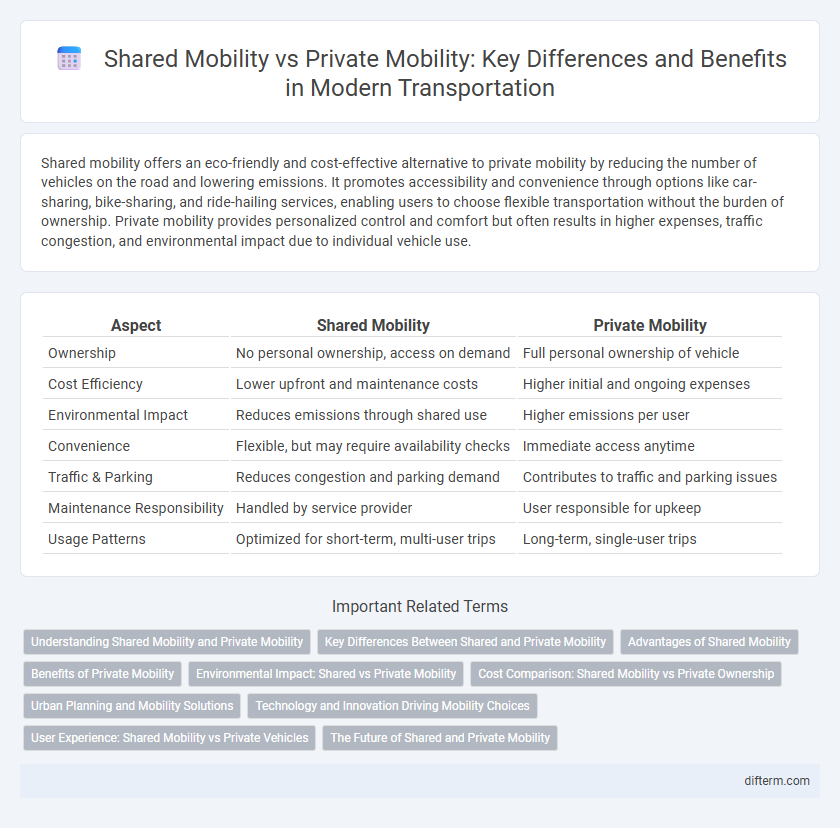Shared mobility offers an eco-friendly and cost-effective alternative to private mobility by reducing the number of vehicles on the road and lowering emissions. It promotes accessibility and convenience through options like car-sharing, bike-sharing, and ride-hailing services, enabling users to choose flexible transportation without the burden of ownership. Private mobility provides personalized control and comfort but often results in higher expenses, traffic congestion, and environmental impact due to individual vehicle use.
Table of Comparison
| Aspect | Shared Mobility | Private Mobility |
|---|---|---|
| Ownership | No personal ownership, access on demand | Full personal ownership of vehicle |
| Cost Efficiency | Lower upfront and maintenance costs | Higher initial and ongoing expenses |
| Environmental Impact | Reduces emissions through shared use | Higher emissions per user |
| Convenience | Flexible, but may require availability checks | Immediate access anytime |
| Traffic & Parking | Reduces congestion and parking demand | Contributes to traffic and parking issues |
| Maintenance Responsibility | Handled by service provider | User responsible for upkeep |
| Usage Patterns | Optimized for short-term, multi-user trips | Long-term, single-user trips |
Understanding Shared Mobility and Private Mobility
Shared mobility involves transportation services and resources used by multiple users, such as car-sharing, bike-sharing, and ride-hailing platforms, reducing the need for individual car ownership and lowering urban congestion and emissions. Private mobility centers on personal vehicle ownership, offering greater convenience and control but contributing to higher traffic congestion, increased greenhouse gas emissions, and urban space consumption. Understanding the environmental impact and cost-efficiency differences between shared and private mobility is crucial for planning sustainable urban transportation systems.
Key Differences Between Shared and Private Mobility
Shared mobility offers cost-effective, environmentally friendly transportation through services like bike-sharing, ride-hailing, and car-sharing, reducing the need for vehicle ownership. Private mobility provides personal convenience, flexibility, and control with individually owned vehicles but incurs higher expenses and greater environmental impact. Key differences lie in ownership structure, user cost, accessibility, and sustainability outcomes, with shared mobility emphasizing resource efficiency and reduced urban congestion.
Advantages of Shared Mobility
Shared mobility reduces traffic congestion and lowers greenhouse gas emissions by optimizing vehicle usage and encouraging carpooling. It offers cost savings through reduced ownership expenses, including maintenance, insurance, and parking fees. Enhanced accessibility and flexibility make shared mobility an efficient solution for urban commuters seeking sustainable and affordable transportation options.
Benefits of Private Mobility
Private mobility offers unparalleled convenience and flexibility, enabling users to travel according to personal schedules without dependency on external factors. It provides enhanced comfort and privacy, making long commutes and spontaneous trips more enjoyable and stress-free. Ownership of private vehicles also allows complete control over maintenance, safety features, and personalization, contributing to a tailored travel experience.
Environmental Impact: Shared vs Private Mobility
Shared mobility significantly reduces the environmental impact by lowering the number of vehicles on the road, resulting in decreased greenhouse gas emissions and reduced air pollution compared to private mobility. Studies show that car-sharing and ride-hailing services can cut carbon emissions per passenger mile by up to 50% due to higher occupancy rates and optimized vehicle usage. In contrast, private mobility often leads to increased congestion, higher energy consumption, and greater urban land use for parking, contributing to a larger carbon footprint.
Cost Comparison: Shared Mobility vs Private Ownership
Shared mobility services such as ride-sharing and bike-sharing typically offer lower upfront and maintenance costs compared to private vehicle ownership, which involves expenses like insurance, fuel, parking, and depreciation. Cost efficiency in shared mobility is enhanced through economies of scale and pay-per-use models, reducing financial burden for occasional users. In urban areas, shared mobility can decrease total transportation expenditure by minimizing fixed costs and enabling flexible, demand-based access to vehicles.
Urban Planning and Mobility Solutions
Shared mobility solutions reduce urban congestion and lower carbon emissions by optimizing vehicle usage and encouraging multimodal transport integration. Urban planning that prioritizes shared mobility infrastructure, such as dedicated lanes and accessible pick-up/drop-off zones, enhances spatial efficiency and promotes sustainable city growth. Private mobility often demands extensive parking space and contributes to traffic overcrowding, challenging the development of pedestrian-friendly urban environments.
Technology and Innovation Driving Mobility Choices
Advanced technologies such as AI-powered ride-sharing platforms and electric vehicle integration are revolutionizing shared mobility by enhancing efficiency and reducing environmental impact. Innovations in battery storage and autonomous driving further accelerate the shift from private car ownership to shared mobility solutions. Data analytics and real-time connectivity optimize route planning and vehicle usage, making shared mobility a smarter and more sustainable transportation choice compared to private mobility.
User Experience: Shared Mobility vs Private Vehicles
Shared mobility offers enhanced convenience through app-based booking, reduced parking hassles, and access to diverse vehicle options, improving overall user experience in urban environments. Private vehicles provide greater control, privacy, and personalized comfort, catering to users who prioritize autonomy and consistent availability. User satisfaction in shared mobility rises with seamless integration of real-time data and efficient vehicle distribution, while private mobility excels in reliability and familiarity.
The Future of Shared and Private Mobility
The future of shared and private mobility hinges on integrating advanced technologies such as electric and autonomous vehicles, which aim to reduce urban congestion and carbon emissions. Shared mobility platforms are projected to expand rapidly, leveraging real-time data and AI to optimize routes and vehicle availability, making transportation more efficient and affordable. Private mobility will evolve with smarter, connected cars offering enhanced comfort and personalized experiences, but the shift towards shared solutions is expected to redefine urban mobility landscapes globally.
shared mobility vs private mobility Infographic

 difterm.com
difterm.com